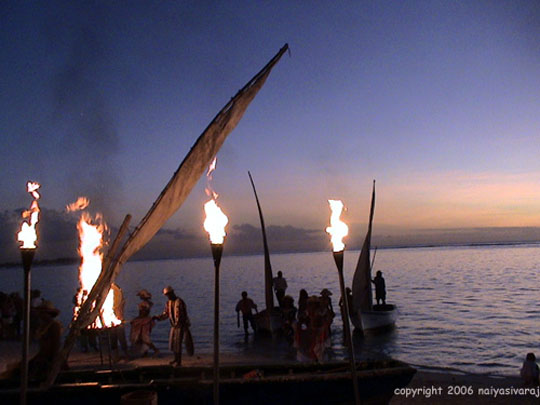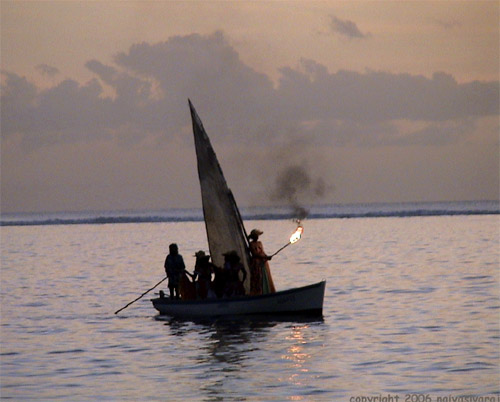Dec 13, 2025
Dec 13, 2025
We had heard that there was to be a sega dance performance on the beach facing the Troux aux Biches resort, and were duly invited by my hawker friend Mootoosaamy ' who bluntly announced that he was a cocktail ' mixed lineage of south Indian, African, Cr'ole. 'And', he laughs, 'my name is Tamil and is really spelt that way'. That mixture is suggestive in the sega too ' the thoroughly simple dance of Mauritius, but therein lay a veiled sensuality. We're soon sitting there, watching a bonfire being built on the sands. Like us, most of the audience is couples and I can see why. Fireside dancing combined with a glorious sunset is romance itself. Just when the sky is highlighted in gold and reds, there is a pounding of drums in the distance and the crowd perks up as it grows louder. The closer it gets, the more haunting it sounds. The sight is as spectacular. Almost as an addition to the painted twilight, the shadow of two catamarans floated in. Lighted torches with lusty singing accompany the troupe's entry. The unexpected appearance thrilled the spectators and everyone became animated at once. The women dressed in striking flowered outfits of itsy-bitsy blouses, and ruffled, flowing skirts are moving their hips sensually to the music. Feet shuffling back and forth, a lithe bending of torsos and now-fiercely-now-slowly gyrating hip movements make up the sega dance. The words are Cr'ole and quite meaningless to everybody. Music and dance however, is a great universal language I see. Although they don't understand the lyrics, they appreciate the rhythm; the hypnotic beat has crept into the crowd and soon several of the audience has eagerly joined in. After the half-hour performance, I met the dancers for a curious chat. The origin of the word 'sega' is relatively unknown 18-year-old Veronique tells me; it goes back to the early 1800s when it was referred to as the 'chega' or 'tchega'. While mostly derived from Mozambique, the rhythm is definitely all African - strong, throbbing, reminiscent of its great, vast jungles and plains. Brought into Mauritius and the other Indian Ocean islands by African slaves, the sega was perhaps performed at nights to drive away the hopeless pining for their lost homes. That pain is still mirrored in the music, although the movements have evolved into something more lively and fun. During colonial times, the sega was forbidden, as was everything else for slaves. After a long day working the sugarcane fields, they would gather in the midst of their huts to make music. If caught at it, they were often whipped or locked away. The song of exile, the song of their life, had to turn into the song of death. Soon, it was merely used for mourning during funeral rites. Over the years, with the exit of the colonials, the sega turned into a form of amusement, and more often a dance of seduction and courtship. Just as in the old days, Cr'ole communities get together often when the elders watch fondly over their youngsters courting. Single men and women move together, whirling and swaying their hips suggestively, while rarely touching each other. 'In every island, it is of a slightly different form' Veronique adds. Just as it is hearty and animated here, it is of a slower, unhurried pace in the Seychelles. That evocative drumbeat so synonymous with the sega is got from a flat drum called the 'ravane' which is a circular piece of wood covered with cured goatskin; and with the 'maravane', a kind of tambourine, a wooden frame filled with seeds, pebbles or shells (both of which take a lot of patience and time to craft). Outside influence is there of course; other cultures like Indian have seeped in, so sometimes the violin or the accordion is used as well. Even as several instruments have been lost to time, the music remains ancient and has been passed on from generation to generation. 

The heartache of somebody was once echoed in those beats. Its sounds, the pain of an uprooted soul; a reverberation that suggests the deep yearning of a man who knows he has lost his complete identity forever. It has now become a content symbol of the once suppressed people. It has gone even beyond that and become truly national - African, Indian, or Creole, everyone is a part of it. In Mauritius, there goes by no occasion without the sega. This is the legacy of their forefathers, and they are going to keep it that way.
29-Oct-2006
More by : Naiya Sivaraj